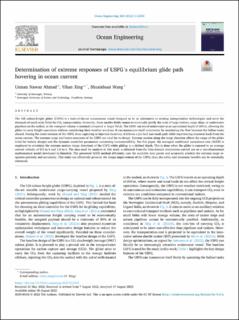| dc.contributor.author | Ahmad, Usman Nawaz | |
| dc.contributor.author | Xing, Yihan | |
| dc.contributor.author | Wang, Shuaishuai | |
| dc.date.accessioned | 2023-03-22T09:55:41Z | |
| dc.date.available | 2023-03-22T09:55:41Z | |
| dc.date.created | 2022-08-18T11:57:45Z | |
| dc.date.issued | 2022 | |
| dc.identifier.citation | Ahmad, U. N., Xing, Y., & Wang, S. (2022). Determination of extreme responses of USFG's equilibrium glide path hovering in ocean current. Ocean Engineering, 263, 112343. | en_US |
| dc.identifier.issn | 0029-8018 | |
| dc.identifier.uri | https://hdl.handle.net/11250/3059753 | |
| dc.description.abstract | The UiS subsea-freight glider (USFG) is a state-of-the-art autonomous vessel designed to be an alternative to existing transportation technologies and serve the demands of small-scale fields for CO2 transportation. Generally, these smaller fields cannot economically justify the costs of large tankers, cargo ships, or underwater pipelines on the seabed, as the transport volume is nominal compared to larger fields. The USFG can travel underwater at an operational depth of 200 m, allowing the glider to carry freight operations without considering ideal weather windows. It can manoeuvre itself underwater by monitoring the flow between the ballast tanks aboard. During the entire mission of the USFG, from capturing to injection locations, it follows a pre-laid saw-tooth path while experiencing transient loads from the ocean current. The extreme surge and heave responses of the USFG are vital for its design. Extreme motion along the surge direction affects the range of the glider (vital for battery design) and the dynamic controller parameters concerning manoeuvrability. For this paper, the averaged conditional exceedance rate (ACER) is employed to scrutinize the extreme motion (surge direction) of the USFG while gliding to a defined depth. This is done when the glider is exposed to an average current velocity of 0.5 m/s and 1.0 m/s. The data used for analysis in this study is obtained from the time-domain simulations carried out on a two-dimensional mathematical model developed in Simulink. The presented ACER method efficiently uses the available data points and accurately predicts the extreme surge responses precisely and accurately. This study can effectively promote the design improvement of the USFG; thus, the safety and economic benefits can be essentially enhanced. | en_US |
| dc.language.iso | eng | en_US |
| dc.publisher | Elsevier | en_US |
| dc.rights | Navngivelse 4.0 Internasjonal | * |
| dc.rights.uri | http://creativecommons.org/licenses/by/4.0/deed.no | * |
| dc.title | Determination of extreme responses of USFG’s equilibrium glide path hovering in ocean current | en_US |
| dc.type | Peer reviewed | en_US |
| dc.type | Journal article | en_US |
| dc.description.version | publishedVersion | en_US |
| dc.rights.holder | The authors | en_US |
| dc.subject.nsi | VDP::Teknologi: 500 | en_US |
| dc.source.volume | 263 | en_US |
| dc.source.journal | Ocean Engineering | en_US |
| dc.identifier.doi | 10.1016/j.oceaneng.2022.112343 | |
| dc.identifier.cristin | 2044121 | |
| cristin.ispublished | true | |
| cristin.fulltext | original | |
| cristin.qualitycode | 1 | |

